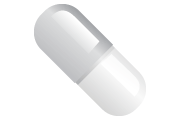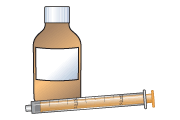Fluconazole for yeast and fungal infections
This leaflet is for parents and carers about how to use this medicine in children. Our information may differ from that provided by the manufacturers, because their information usually relates to adults. Read this leaflet carefully. Keep it somewhere safe so that you can read it again.
Name of medicine
Fluconazole
Brand names: Diflucan
Why is it important for my child to take Fluconazole?
Your child has an infection caused by a yeast or fungus. Fluconazole causes damage to the membrane of yeast and fungal cells and stops the cells growing and multiplying. This gets rid of the infection, or stops an infection from developing.
Some of the yeast or fungus may remain after the infection has gone. It is therefore important that you continue to give the medicine as your doctor has prescribed, to make sure all of the yeast or the fungus is killed, otherwise the infection may come back. Do not stop early.
What is Fluconazole available as?
- Capsules: 50 mg, 150 mg, 200 mg, these contain lactose
- Liquid medicine (oral suspension): 50 mg in 5 mL
If you have any concerns or questions, speak with your child’s doctor or pharmacist.
When should I give Fluconazole
Fluconazole is usually given once each day. This is usually in the morning.
However, in babies this may be once every two or three days.
Your doctor will tell you which days to give the medicine. You can write these days in your diary to remind you and so that you have a record of when you last gave it.
Give the medicine at about the same time(s) each day so that this becomes part of your child’s daily routine, which will help you to remember.
How much should I give?
Your doctor will work out the amount of Fluconazole (the dose) that is right for your child. The dose will be shown on the medicine label.
It is important that you follow your doctor’s instructions about how much to give.
How should I give Fluconazole?

Capsules
- Capsules should be swallowed with a glass of water, squash or juice. Your child should not chew the capsule.

Liquid medicine (oral suspension)
- Shake the medicine well.
- Measure out the right amount using an oral syringe or a medicine spoon. You can get these from your pharmacist. Do not use a kitchen teaspoon as it will not give the right amount.
When should the medicine start working?
Your child should start to feel better within a few days to one week of starting the medicine. They should continue to take the medicine even after they feel better, as it takes a while to kill all of the yeast or the fungus. If you are worried about whether it is helping, contact your doctor.
What if my child is sick (vomits)?
- If your child is sick less than 30 minutes after having a dose of Fluconazole, give them the same dose again.
- If your child is sick more than 30 minutes after having a dose of Fluconazole, do not give them another dose. Wait until the next normal dose.
If your child is sick again, seek advice from your family doctor, nurse, pharmacist, or hospital. They will decide what to do based on your child’s condition and the specific medicine involved.
What if I forget to give it?
If you usually give it once a day in the morning: Give the missed dose when you remember during the day, as long as this is at least 12 hours before the next dose is due.
If you usually give it once a day in the evening: If you remember before bedtime, give the missed dose. You do not need to wake a sleeping child to give a missed dose. You can give the missed dose in the morning, as long as this is at least 12 hours before the evening dose is due.
Never give a double dose of Fluconazole.
What if I give too much?
You are unlikely to cause harm if you give an extra dose of Fluconazole by mistake. If you are concerned that you may have given too much, contact your doctor or local NHS services (details at end of leaflet). Have the medicine or packaging with you if you telephone for advice.
Are there any possible side effects?
We use medicines to make our children better, but sometimes they have other effects that we don’t want (side effects).
Side effects you must do something about
If your child is short of breath or is wheezing, or their face, lips or tongue start to swell, or they develop a rash, they may be allergic to Fluconazole. Take your child to hospital or phone for an ambulance straight away.
Very rarely, Fluconazole can cause seizures (fits). If your child has a seizure, telephone for an ambulance. Do not restrain your child but try to make sure that they cannot hurt themselves (e.g. put a cushion under their head and move them away from furniture).
If your child has a severe rash, unusual bruising or bleeding, or bleeding from their gums or nose, or if their skin or eyes look yellow, contact your doctor or take them to hospital straight away, as there may be a problem with your child’s liver.
If your child has an irregular or fast heart beat (they may say their heart feels fluttery or is racing), or if they seem drowsy, agitated or confused, contact your doctor straight away.
Other side-effects you need to know about
These side-effects should stop when you stop the course of fluconazole, but if you are worried about any of them, contact your doctor.
- Your child may feel sick (nausea) or be sick (vomit). They may also have taste disturbance (they may say things taste funny), mild abdominal pain, indigestion or heartburn, flatulence (wind) or diarrhoea. Giving the medicine with some food may help.
- Your child’s hair may become thinner and some may fall out. It should grow back when the medicine is stopped.
Your child’s hair may become thinner and some may fall out. It should grow back when the medicine is stopped. Discuss this with your doctor at your next visit.
There may sometimes be other side effects that are not listed above. If you notice anything unusual and are concerned, contact your doctor. You can report any suspected side effects to a UK safety scheme at mhra.gov.uk/yellowcard
Can other medicines be given at the same time as Fluconazole?
- You can give your child medicines that contain paracetamol or ibuprofen, unless your doctor has told you not to.
- Fluconazole should not be taken with some medicines. Tell your doctor or pharmacist about any other medicines your child is taking before giving Fluconazole.
Check with your doctor or pharmacist before giving any other medicines to your child. This includes herbal and complementary medicines.
Is there anything else I need to know about this medicine?
- Children with porphyria should not take fluconazole. If your child has porphyria, or you have a family history of the condition, tell your doctor.
- If your child is taking fluconazole to treat an infection, it is important that they take the whole course of treatment. The yeast or fungus may remain after your child starts to feel well; however, it is important to kill all the yeast or fungus, to make sure that the infection doesn’t come back.
- Fluconazole may harm an unborn baby. If your daughter is having sex, it is very important that she uses adequate contraception to prevent unplanned pregnancy and continues it for at least 1 month after stopping the treatment. If your daughter thinks that she may be pregnant, she should not take Fluconazole.
General advice about medicines
- Try to give medicines at about the same times each day, to help you remember.
- Only give this medicine to your child. Never give it to anyone else, even if their condition appears to be the same, as this could do harm.
- If you think someone else may have taken the medicine by accident, contact your doctor or NHS local services (details at end of leaflet) for advice.
- Make sure that the medicines you have at home have not reached the ‘use by’ date on the packaging. Give old medicines to your pharmacist to dispose of.
- If you are not sure a medicine is working, contact your doctor but continue to give the medicine as usual in the meantime. Do not give extra doses, as you may do harm.
Where should I keep this medicine?
- Keep the medicine in a cupboard, away from heat and direct sunlight.
- It does not need to be kept in the fridge.
- Make sure that children cannot see or reach the medicine.
- Keep the medicine in the container it came in.
Who to contact for more information?
Your child’s doctor, pharmacist or nurse will be able to give you more information about Fluconazole and about other medicines used to treat infections.
England: NHS 111
Tel 111
www.nhs.ukScotland: NHS 24
Tel 111
www.nhs24.scotNorthern Ireland: NI Direct
Wales: NHS 111 Wales
Tel 111
www.111.wales.nhs.ukCopyright disclaimer
Version [1]. © NPPG, RCPCH and WellChild, all rights reserved. Review by July 2019.
The primary source for the information in this leaflet is the British National Formulary for Children. For details on any other sources used for this leaflet, please contact us through our website, www.medicinesforchildren.org.uk.
We take great care to make sure that the information in this leaflet is correct and up-to-date. However, medicines can be used in different ways for different patients. It is important that you ask the advice of your doctor or pharmacist if you are not sure about something. This leaflet is about the use of these medicines in the UK, and may not apply to other countries. The Royal College of Paediatrics and Child Health (RCPCH), the Neonatal and Paediatric Pharmacists Group (NPPG), WellChild and the contributors and editors cannot be held responsible for the accuracy of information, omissions of information, or any actions that may be taken as a consequence of reading this leaflet.
